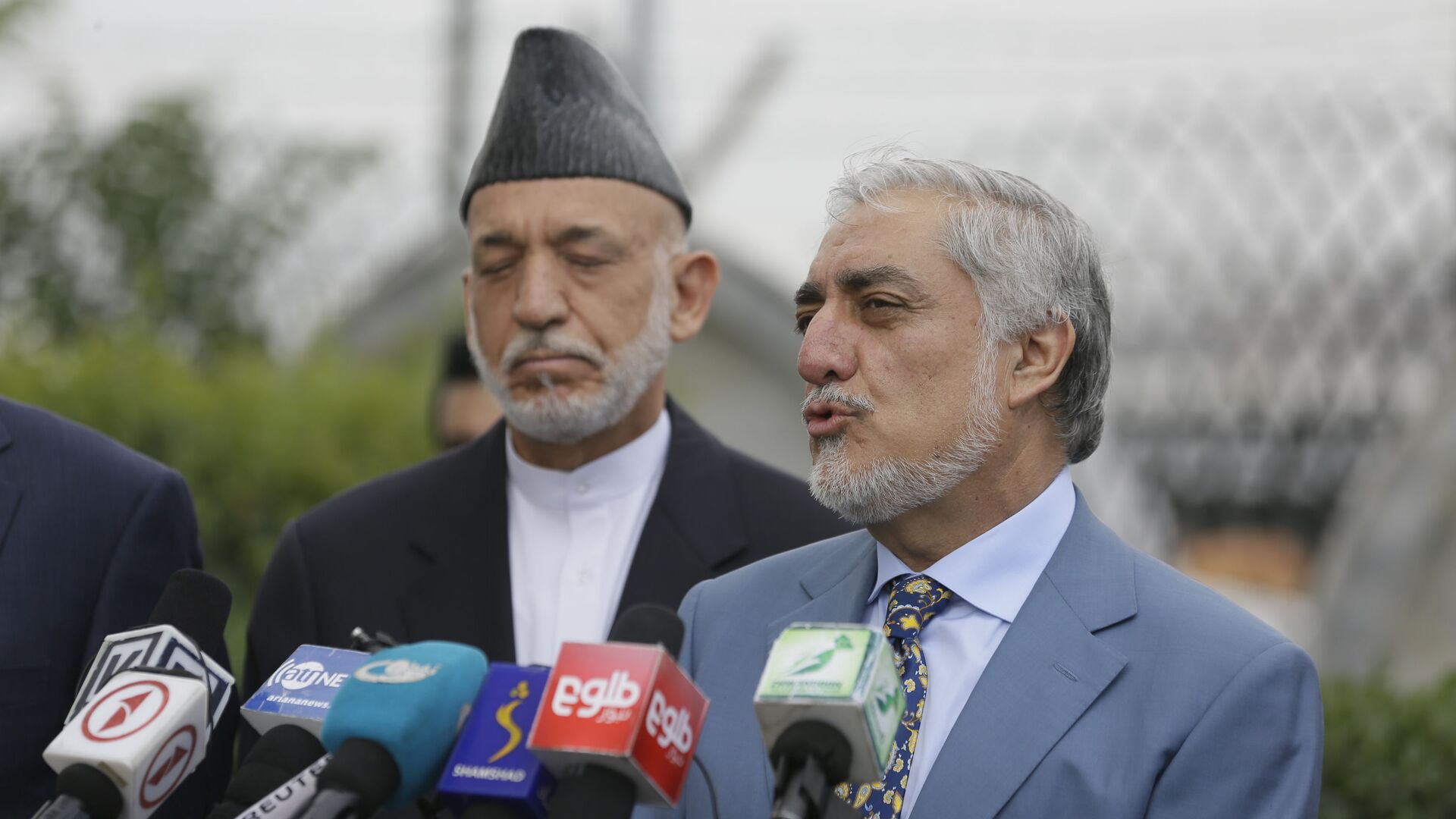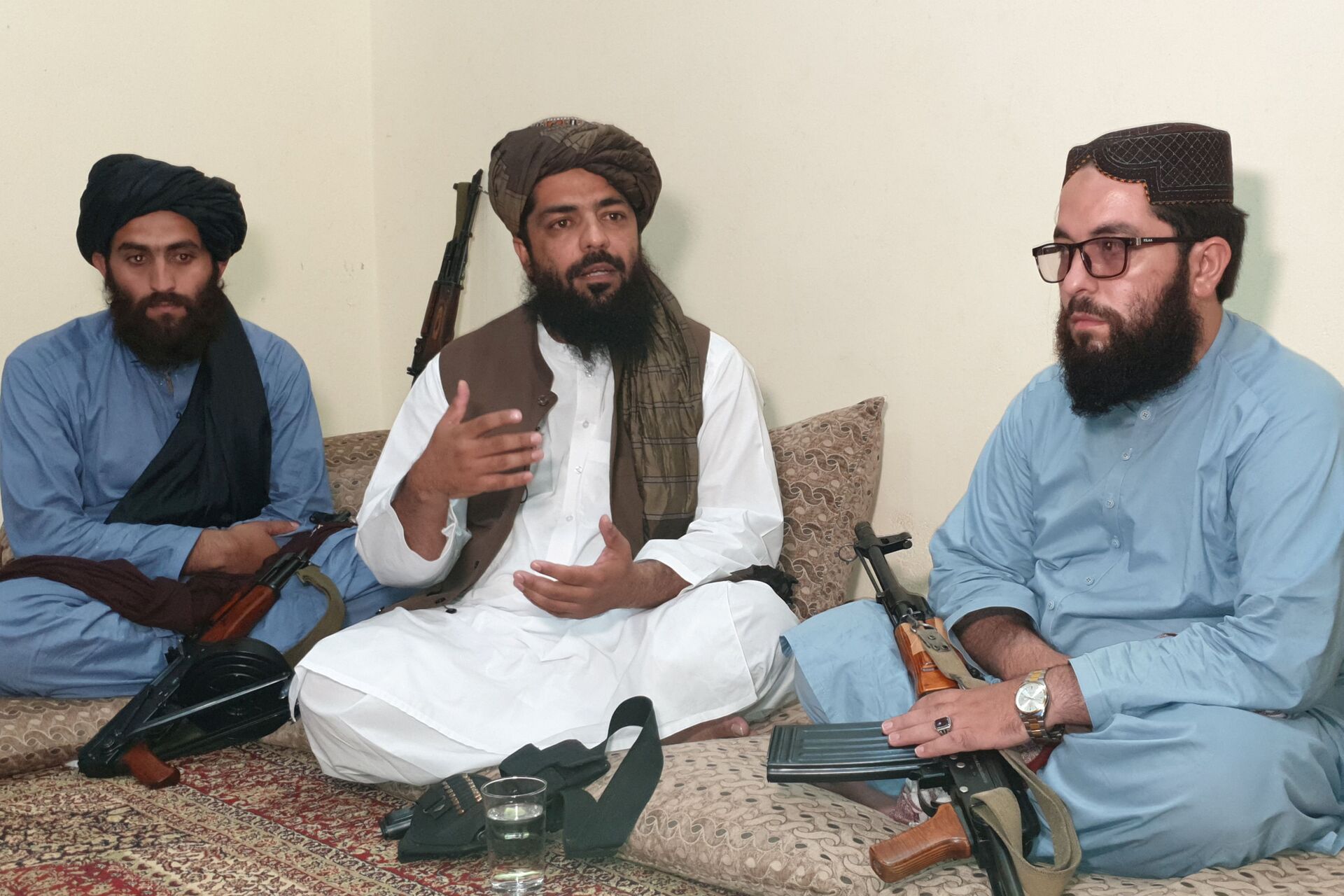Afghan Ex-President Karzai, Reconciliation Chief Abdullah Talk Peace With Taliban’s Anas Haqqani

© AP Photo / Mariam Zuhaib
Subscribe
After the deadly chaos that gripped Kabul airport amid a Taliban seizure of power on Sunday, thousands of US troops arrived and negotiations began with the Islamic militia to allow US officials and others to leave the country if they wish.
Delegations from the deposed Afghan government and the Taliban insurgency, which seized the capital over the weekend, have met for peace talks as the Taliban seeks to form a new government.
According to a Taliban official who spoke with Reuters, the Wednesday meeting occurred between former Afghan President Hamid Karzai and Afghan reconciliation chief Abdullah Abdullah on the government’s side and Anas Haqqani, a senior official in the Haqqani Network, a faction of the Taliban, on the other.
Not mentioned in the report was the third leader of the Afghan government’s reconciliation team, Gulbuddin Hekmaytar, a warlord who leads the Hezbi-Islami militia and once fought alongside
Anas Haqqani’s father, Jalaluddin Haqqani, when they both were US-backed mujahideen fighting the Soviets, but who later mounted his own bid for power opposite the Taliban in the civil war that ensued after the socialist government was overthrown in 1992.
A spokesperson for Karzai’s office told the Associated Press that the meeting was intended to set the stage for negotiations with Mullah Abdul Ghani Baradar, the Taliban’s top political leader who is expected to become the head of state of the Taliban’s new government.
After the Taliban secured the surrender of Kabul on Sunday, at least a month before American officials expected the capital to come under threat, then-Afghan President Ashraf Ghani suddenly fled the country, first going to Uzbekistan before going to the United Arab Emirates.
Speaking Wednesday from the UAE, Ghani rejected claims he’d fled with suitcases stuffed full of money, saying he only left Afghanistan to prevent further bloodshed.
As the Taliban seized the capital city, Karzai, a former CIA asset who fought for the Americans during the 2001 invasion before becoming interim president from 2001 until 2004, then president from 2004 until 2014, posted a video online saying he hoped “to solve the issue of Afghanistan with the Taliban leadership peacefully.”
After Ghani’s flight on Sunday, his now-former vice president, Amrullah Saleh, declared himself to be the caretaker president. Saleh is believed to be in the Panjshir Valley north of Kabul, and a photo of him on August 15 showed him sitting next to Ahmad Massoud, son of the legendary guerilla fighter and Northern Alliance leader Ahmad Shah Massoud, who resisted Taliban rule and was assassinated two days before the September 11, 2001, terrorist attacks by al-Qaeda in the United States.
Clarity: As per d constitution of Afg, in absence, escape, resignation or death of the President the FVP becomes the caretaker President. I am currently inside my country & am the legitimate care taker President. Am reaching out to all leaders to secure their support & consensus.
— Amrullah Saleh (@AmrullahSaleh2) August 17, 2021
Taliban Brings Sharia
Meanwhile in Kabul, the Taliban is attempting to establish an air of international legitimacy and reconciliation, promising to form an “inclusive, Islamic” government and offering amnesty to government workers, who have been urged to return to work.
However, at the same time they have totally rejected western notions of democratic government, with Taliban spokesperson Waheedullah Hashimi telling Reuters, "There will be no democratic system at all because it does not have any base in our country. We will not discuss what type of political system we should apply in Afghanistan because it is clear. It is Sharia law and that is it.”
The Taliban ruled the country from 1996 until 2001 after winning the civil war, but only being recognized as the Afghan government by Saudi Arabia, the UAE, and Pakistan. Like their rival groups, including Hekmatyar’s, Haqqani’s, and Massoud’s, the Taliban began as insurgents against the socialist Afghan government and their Soviet allies, being armed for the fight by the United States and Pakistan.
The government outlined by a Taliban spokesperson at a Tuesday press conference is close to the structure from that era, with a ruling council making day-to-day decisions and Baradar presiding from afar. Their rule was known for being extremely socially restrictive, especially of the rights of women and girls, who were denied the ability to go to school or to work, to show their faces in public, or to travel outside the home without a male relative.
However, the Taliban was also known for effectively clamping down on the opium trade, which flourished before and after their rule, but saw its lowest output in decades between 1996 and 2001.

Waheedullah Hashimi (C), a senior Taliban commander, gestures as he speaks with Reuters during an interview at an undisclosed location near Afghanistan-Pakistan border August 17, 2021. Picture taken August 17, 2021.
© STRINGER
The United Nations on Monday called on the Taliban to form an inclusive government that included members of other groups, as well as women, and to reject support for terrorism or terrorist groups like al-Qaeda.
“Our ulema [scholars] will decide whether girls are allowed to go to school or not,” Hashimi told Reuters. “They will decide whether they should wear hijab, burqa, or only [a] veil plus abaya or something, or not. That is up to them.”
Vying for International Legitimacy
Unlike during their first takeover, a number of nations have already spoken favorably of the potential for future cooperation with a Taliban government on issues of regional stability and trade, including Russia, China, Iran, and Turkey.
“If we are going to recognize a government, we will have to wait till the government is formed,” Chinese Foreign Ministry spokesperson Zhao Lijian said Wednesday. “Only after that, will we come to the question of diplomatic recognition.”
China’s major concern in a Taliban-ruled Afghanistan has been the group’s past harboring of the East Turkestan Islamic Movement (ETIM), an Islamic terrorist group that aims to separate the Xinjiang Autonomous Region from the rest of China and has carried out deadly terrorist attacks in the country.
However, with promises that support will end, Zhao said that “China will continue to support the peaceful reconstruction of Afghanistan and provide assistance to Afghanistan’s economic and social development within its capacity.”
Washington has so far plotted an ambiguous position in the aftermath of the overthrow of the government it worked nearly 20 years to build up, arm, and support. On Tuesday, US Secretary of State Antony Blinken told CNN that the US “could recognize” the Taliban government if it respects human rights and doesn’t harbor terrorists, but warned that if not, sanctions would remain in place. At present, Afghanistan’s $9 billion in assets in Washington are frozen.
In addition, US national security adviser Jake Sullivan said Tuesday that "at this point, [Ghani] is no longer a factor.”



